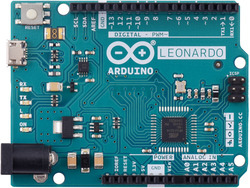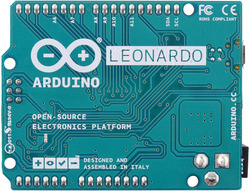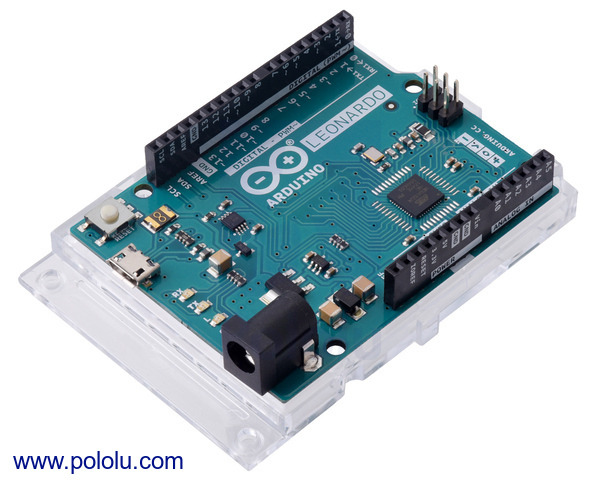Arduino Leonardo
The Arduino Leonardo is a microcontroller board based on the ATmega32U4. It has 23 digital input/output pins (of which 7 can be used as PWM outputs and 12 as analog inputs), a 16 MHz crystal oscillator, a micro USB connection, a power jack, an ICSP header, and a reset button. It contains everything needed to support the microcontroller; simply connect it to a computer with a USB cable or power it with a AC-to-DC adapter or battery to get started (USB cable and power supply are not included). This board ships with the female header pins soldered in, as shown in the product picture.
| Description | Specs (11) | Pictures (4) | Resources (13) | FAQs (0) | On the blog (2) | Distributors (0) |
|---|
 |
Arduino Leonardo, top view. |
|---|
 |
Arduino Leonardo, bottom view. |
|---|
Note: There are differences between the Leonardo and previous Arduino boards. As such, there could be incompatible Arduino shields and libraries. The Leonardo works with our motor and robot shields, and it works with our Wixel shield in a limited capacity: the wireless serial features work, but the wireless reprogramming does not.
Overview
The Arduino Leonardo is a microcontroller board based on the ATmega32U4. It has 23 digital input/output pins (of which 7 can be used as PWM outputs and 12 can be used as analog inputs), a 16 MHz crystal, a USB connection, a power jack, an in-circuit system programming (ICSP) header, and a reset button. It contains everything needed to support the microcontroller; simply connect it to a computer with a Micro USB cable or power it with a AC-to-DC adapter or battery to get started (USB cable and power supply are not included). This board ships with the power jack and through-hole headers soldered in, as shown in the product picture.
The Leonardo differs from all preceding Arduino boards in that the user-programmable ATmega32U4 AVR microcontroller has built-in USB functionality, eliminating the need for a secondary processor. This makes the Leonardo more versatile: in addition to supporting a virtual (CDC) serial/COM port interface, it can appear to a connected computer as a mouse and keyboard. See Arduino’s getting started page for more implications of the Leonardo’s single-MCU design.
The Arduino has a large support community and an extensive set of support libraries and hardware add-on “shields” (e.g. you can easily make your Arduino wireless with our Wixel shield), making it a great introductory platform for embedded electronics. Note that we also offer a SparkFun Inventor’s Kit, which includes an Arduino Uno along with an assortment of components (e.g. breadboard, sensors, jumper wires, and LEDs) that make it possible to create a number of fun introductory projects.
More information about the Arduino Leonardo is available on Arduino’s website. Note that the Leonardo only works with the Arduino IDE version 1.0.1 or later.
Warning: We recommend not connecting the Arduino to USB while it is powered through VIN. See this forum post for more information.
Choosing the right controller
The table below compares the Arduino Uno, Leonardo, and our A-Star 32U4 Prime controllers. The A-Star Primes are based on the same ATmega32U4 AVR microcontroller as the Leonardo and ship with Arduino-compatible bootloaders, so they can be used a direct substitutes for the Leonardo in typical applications. The Primes also offer many advantages, including superior power management that enables efficient operation from 2.7 V to 11.8 V (LV version) or 5 V to 36 V (SV version).
 Arduino Uno R3 |
 Arduino Leonardo |
 A-Star 32U4 Prime LV |
 A-Star 32U4 Prime SV |
||
|---|---|---|---|---|---|
| Microcontroller: | ATmega328P | ATmega32U4 | ATmega32U4 | ||
| Clock: | 16 MHz resonator | 16 MHz crystal | 16 MHz crystal | ||
| User I/O lines: | 20 | 23 | 26 | ||
| PWM outputs: | 6 | 7 | 7 | ||
| Analog inputs: | 6 | 12 | 12 | ||
| Ground access points: | 4 | 4 | 43 | ||
| User LEDs: | 3 | 3 | 3 | ||
| User pushbuttons: | — | — | 3 | ||
| Reset button: |  |
 |
 |
||
| Power switch: |  |
||||
| Buzzer option: |  |
||||
| microSD option: |  |
||||
| LCD option: |  |
||||
| Arduino-compatible bootloader: |
 |
 |
 |
||
| USB connector: | B | Micro-B | Micro-B | ||
| USB/regulator power selection: |
partial | partial | TPS2113A | ||
| High-performance reverse-voltage protection: |
 |
||||
| Recommended input voltage: |
7 V to 12 V | 7 V to 12 V | 2 V to 16 V | 5 V to 36 V | |
| Regulator type (5 V): | linear | linear | switching step-up/step-down |
switching step-down |
|
| Available 5 V output current: |
at 3 V in | — | — | 0.75 A | — |
| at 5 V in | — | — | 1.5 A | 0.2 A | |
| at 7 V in | 1.0 A | 1.0 A | 1.9 A(1) | 1.0 A | |
| at 9 V in | 0.5 A | 0.5 A | 1.9 A(1) | 1.0 A | |
| at 11 V in | 0.35 A | 0.35 A | 1.8 A | 1.0 A | |
| at 24 V in | — | — | — | 1.0 A | |
| via USB connector |
0.5 A(2) | 0.5 A(2) | 1.9 A(3) | 1.9 A(3) | |
| Weight: | 28 g | 20 g | 13 g to 33 g | ||
| Price: | $27.60 | $24.95 | $33.40 to $53.00 | ||
| 1 There is more available 5 V output current via VREG, see maximum regulator output current graph for details. | |||||
| 2 With sufficient USB power supply. | |||||
| 3 Nominal current available through power MUX with sufficient USB power supply. | |||||
 |
Side-by-side comparison of the A-Star 32U4 Prime LV microSD to the Arduino Leonardo. |
|---|
We also carry a variety of other programmable controllers, from the beginner-friendly BASIC Stamp to the far more capable mbed and Raspberry Pi boards, which are based on powerful ARM processors. Our full selection can be found in our Programmable Controllers category.
People often buy this product together with:
 |
Sharp/Socle GP2Y0A21YK0F Analog Distance Sensor 10-80cm |
 |
Zumo Reflectance Sensor Array |
 |
75:1 Micro Metal Gearmotor HP 6V |









































